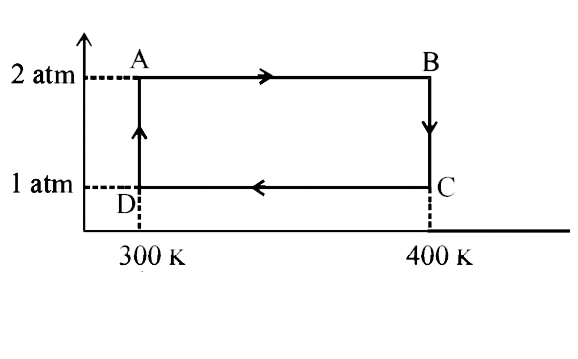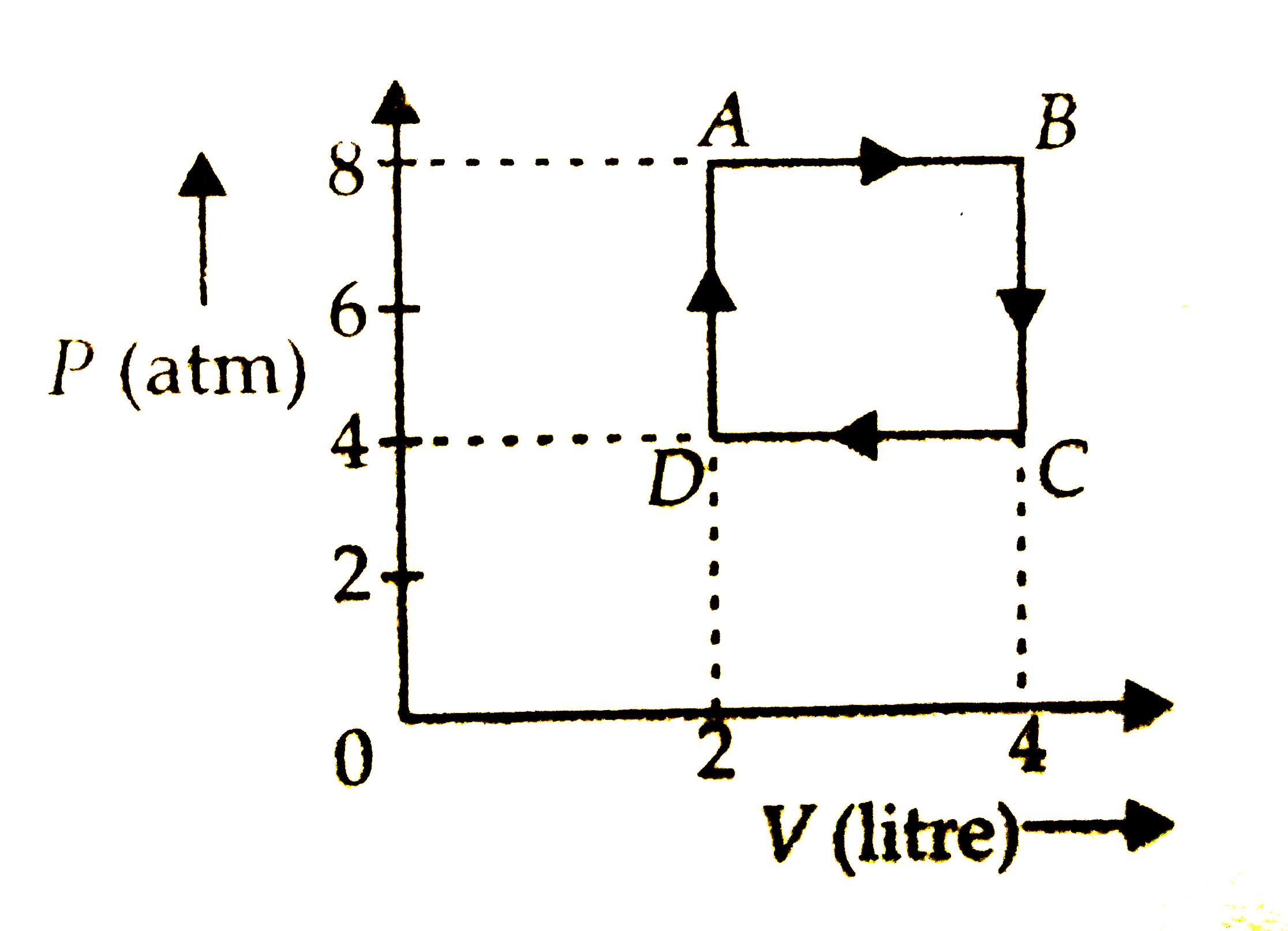Two moles of helium gas undergo a cyclic process as shown in Fig. Assuming the gas to be ideal, calculate the following quantities in this process

(a) The net change in the heat energy
(b) The net work done
(c) The net change in internal energy
As we know in a process, the change in head ererngy of heat shpplied to the gas is equal to the net work done by the gas
Here, AB is isobaric process. Hence, work done during this process form A to B is
WAB=P(V2−V1)=nRT(T2−T1)
or WAB=2×8.314×(400−300)=1662.8J
Work done during isothermal process form B to C is
WBC=nRTC1n(V2/V1)=nRT+(C)1n(P1/P2)
=2×8.314×400×1n(2)=2×8.314×400×0.693
=4601.2J
Work done during isobaric process from C to D
WCD=nR(TD−TC)=2×8.314×(300−400)
=−1662.8J
Work done during isothermal process from D to A
WDA=nRTD1m(PD/PA)
=nRTD1n(2)
=−2×8.314×300x0.693
=−3437.7J
Net down done
=WAB+WBC+WCD+WDA
=1662.8+4610.2n−1662.5=3457.7=1152.5J
Now from the first law of thermodynamics
ΔQ=ΔU+ΔW
Here, ΔQ=ΔW=1152.5J
So the heat given to the system is 1152.5 J
As the gas returns to its original state, there is no change in internal energy.
Topper's Solved these Questions
- KINETIC THEORY OF GASES AND FIRST LAW OF THERMODYNAMICSBOOK - CENGAGE PHYSICS ENGLISHCHAPTER - KINETIC THEORY OF GASES AND FIRST LAW OF THERMODYNAMICSEXERCISE - Exercise 2.1
20 Videos
- KINETIC THEORY OF GASES AND FIRST LAW OF THERMODYNAMICSBOOK - CENGAGE PHYSICS ENGLISHCHAPTER - KINETIC THEORY OF GASES AND FIRST LAW OF THERMODYNAMICSEXERCISE - Exercise 2.2
28 Videos
- KINETIC THEORY OF GASES AND FIRST LAW OF THERMODYNAMICSBOOK - CENGAGE PHYSICS ENGLISHCHAPTER - KINETIC THEORY OF GASES AND FIRST LAW OF THERMODYNAMICSEXERCISE - Interger
11 Videos
- KINETIC THEORY OF GASESBOOK - CENGAGE PHYSICS ENGLISHCHAPTER - KINETIC THEORY OF GASESEXERCISE - Compression
2 Videos
- LINEAR AND ANGULAR SIMPLE HARMONIC MOTIONBOOK - CENGAGE PHYSICS ENGLISHCHAPTER - LINEAR AND ANGULAR SIMPLE HARMONIC MOTIONEXERCISE - Single correct anwer type
14 Videos
Similar Questions
Two moles of helium gas undergo a cyclic process as shown in Fig. 19.2.14. Assuming the gas to be ideal, calculate the following quantitites in this process
(a) the net change in heat energy
(b) the net work done
(c) the net change in internal energy.
View SolutionTwo moles of Helium gas undergo a reversible cyclic process as shown in figure. Assuming gas to be ideal, what is the net work involved in the cyclic process ?

View Solution
Knowledge Check
Two moles of Helium gas undergo a reversible cyclic process as shown in figure. Assuming gas to be ideal, what is the net work involved in the cyclic process ?
 A200 Rln2B100 Rln2C300 Rln2D400 Rln2
A200 Rln2B100 Rln2C300 Rln2D400 Rln2Two moles of Helium gas undergo a reversible cyclic process as shown in figure. Assuming gas to be ideal, what is the net work involved in the cyclic process ?
 A200R ln2B100R ln2C300R ln2D400R ln2
A200R ln2B100R ln2C300R ln2D400R ln2One mole of an ideal gas undergoes a cyclic process ABCDA as shown in the P-V diagram, The net work done in the process is
(1 atm=10^(6) dyne cm^(-2)) A500 JB700 JC800 JD900 J
A500 JB700 JC800 JD900 J
Two moles of a monatomic ideal gas undergo a cyclic process ABCDA as shown in figure. BCD is a semicircle. Find the efficiency of the cycle.

View SolutionA sample of helium is undergoing a cyclic process ABCA as shown. In which of the following processes heat is a absorbed by the gas?

View SolutionTwo moles of an ideal gas are undergone a cyclic process 1-2-3-1. If net heat exchange in the process is 300J, the work done by the gas in the process 2-3 is

View SolutionTwo moles of a monoatomic ideal gas undergoes a process AB as shown in the figure. Then, find the work done during the process in Joule.

View SolutionAn ideal gas undergoes cyclic process ABCDA as shown in given p−V diagram. The amount of work done by the gas is

View Solution
